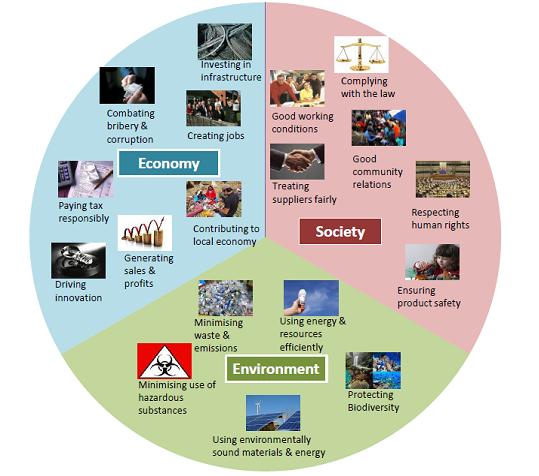STISUSMAN › About sustainable manufacturing and the toolkit
About sustainable manufacturing and the toolkit
Welcome | About the Toolkit | Concept | Business benefits
|
|
Many businesses have already started to take important steps towards green growth – ensuring their development is economically and environmentally sustainable. Their pioneering experiences largely show that environmental improvements go hand in hand with profit-making and improved competitiveness. However, many small and medium-sized businesses (SMEs), that account for approximately 99% of all enterprises and two thirds of employment across the OECD, have not yet embraced these great opportunities. They may be struggling with their short-term survival, or cost pressure from clients, or lack of knowledge and resources to invest in environmental improvement, or simply not know where to start. |
If your business is looking to tackle sustainability – what it means, how it relates to your business, and how you can benefit from greener production - the OECD Sustainable Manufacturing Toolkit is a great place to start. Measuring performance is a vital first step to improvement. The OECD Sustainable Manufacturing Toolkit provides a set of internationally applicable, common and comparable indicators to measure the environmental performance of manufacturing facilities in any business size, sector or country. To make things simpler for those with little experience in this area, the Toolkit offers two components – this step-by-step Start-up Guide and a Web Portal where technical guidance on measurement and relevant links are provided.We think it is important for you to have the right tools, but also to be informed about what works. That’s why we have also included a range of best practice case studies that illustrate the many benefits of sustainable manufacturing. Saving money, improving your products, making your operations more efficient and increasing sales are all possible for those taking up this new challenge.
This Toolkit is the result of a two-year consultation process that involved many practitioners and experts, and the framework it establishes owes much to the existing variety of measurement and reporting initiatives around the world.
We hope that the OECD Sustainable Manufacturing Toolkit will inspire you to get started on your own journey towards sustainable manufacturing today. Comments and suggestions on how to extend, update and improve this Toolkit will be most welcome.
Andrew Wyckoff
Director, Directorate for Science, Technology and Industry, OECD
The OECD Sustainable Manufacturing Toolkit aims to provide a practical starting point for businesses around the world to improve the efficiency of their production processes and products enabling them to contribute to sustainable development and green growth. The Toolkit includes an internationally applicable common set of indicators helping businesses measure their environmental performance at the level of a plant or facility. This edition focuses on the environmental aspects of sustainable development.
The Toolkit comprises:
- A start-up guide, which provides easy-to-read guidance to help the reader understand the basic issues and start measurement step by step. Download the guide.
- A web portal (this website) provides detailed explanation on indicators, technical advice on performance management and links to more guidance.
Together, the start-up guide and web portal will help you get the most out of the content, whether you are a beginner, an expert, or somewhere in between.
This Toolkit has been developed with small and medium-sized manufacturing enterprises in mind. However, the indicators and guidance can also be useful for any other size and type of organisation throughout the world.
“Sustainable manufacturing” is a formal name for an exciting new way of doing business and creating value. It is behind many of the green products and processes in demand and celebrated around the world today. Businesses of all types are already involved in initiatives and innovations that are helping to foster a healthier environment, enhance their competitive edge, reduce risks, build trust, drive investment, attract customers and generate profit.
There is no single common definition of sustainable manufacturing but the US Department of Commerce’s Sustainable Manufacturing Initiative sums it up as: “The creation of manufactured products that use processes that minimize negative environmental impacts, conserve energy and natural resources, are safe for employees, communities, and consumers and are economically sound.”
To put simply, sustainable manufacturing is all about minimising the diverse business risks inherent in any manufacturing operation while maximising the new opportunities that arise from improving your processes and products. The economic, environmental and social aspects embraced by this concept are illustrated below. This Toolkit primarily focuses on helping you to improve the environmental performance of your facility.
Three-dimensional aspects of sustainable manufacturing
These days, doing business built on good environmental practice is increasingly becoming essential in the eyes of investors, regulators, customers and the communities where you operate. Failure brings with it high costs – fines, penalties, local unrest and customers choosing to go elsewhere. Success, on the other hand, can save you money, helps build a reputation, attracts investment, spurs innovation, secures loyal customers and brings in repeat business.
Benefiting from sustainable manufacturing is not just a game for big business. New firms and small businesses can also play an exciting role. Start-ups and small and medium-sized enterprises (SMEs) with their flexible business models and less reliance on established ways of working, can also benefit, evolving and innovating quickly to gain advantage over on the competition. Need more convincing? Take a look at the facts:
-
The green marketplace is worth trillions: A 2010 survey of UK-based manufacturing SMEs shows that 56% are already investing in low-carbon technologies and strategies. The global market for low-carbon products is already estimated to be worth over USD 5 trillion and growing.
-
Retailers are demanding that suppliers respond to green consumers: In 2009, Walmart, the largest retailer in the world, introduced a worldwide sustainability index. The index will be applied to over 100 000 global suppliers to give consumers a clear environmental and social rating for every product it sells.
-
A green reputation drives up your financial value: A study by Harvard and London Business Schools found that financial analysts rate companies with a visible reputation for environmental responsibility higher than others. Conversely, poor performance can be a serious risk. Companies with significant environmental problems, including litigation, have to pay up to 0.64% more to service their debts and secure credit.
-
A little investment in greening may lead to big savings: The UK’s Carbon Trust estimates that most businesses can cut their energy bills by up to 20% with only a small investment – a saving that could equate to as much as a 5% increase in your overall profits.
-
Young workers value sustainability and demand green workplaces: A 2010 survey of 5,300 respondents worldwide, carried out by Johnson Controls Global WorkPlace Solutions, shows that over 96% of 18-45 year olds want their employer and workplace to be environmentally friendly or at least environmentally aware. Over 70% of all respondents would like to share printers and have recycling bins in the office, while 47% want to have water saving devices and solar panels installed on site.
Related Documents


